Andromeda constellation is located in the northern sky, between Cassiopeia’s W asterism and the Great Square of Pegasus. It is one of the 48 Greek constellations, first listed in Claudius Ptolemy’s Almagest in the 2nd century CE.
The constellation was named after the mythical princess Andromeda, the daughter of Queen Cassiopeia and wife of the Greek hero Perseus. It is also known as the Princess, the Chained Maiden, Persea (wife of Perseus), or Cepheis (daughter of Cepheus).
Among other notable deep sky objects, Andromeda constellation contains the famous Andromeda Galaxy (Messier 31) and the dwarf elliptical galaxies Messier 32 and Messier 110. The brightest stars in the constellation — Alpheratz, Mirach and Almach — form a chain between the Great Square of Pegasus and the constellation Perseus.
Facts, location and map
Andromeda is the 19th largest constellation in the sky, occupying an area of 722 square degrees. It is located in the first quadrant of the northern hemisphere (NQ1). The constellation can be seen from locations between the latitudes +90° and -40°. The neighboring constellations are Cassiopeia, Lacerta, Pegasus, Perseus, Pisces and Triangulum.
The constellation name Andromeda is pronounced /ænˈdrɒmɪdə/. In English, the constellation is known as Andromeda, the Princess, or the Chained Maiden. The genitive form of Andromeda, used in star names, is Andromedae (pronunciation: /ænˈdrɒmɪdiː/). The three-letter abbreviation, adopted by the International Astronomical Union (IAU) in 1922, is And.
Andromeda has three stars brighter than magnitude 3.00 and three stars located within 10 parsecs (32.6 light years) of Earth. The brightest star in the constellation is Alpha Andromedae, also known by its traditional name, Alpheratz. The nearest star is Ross 248 (spectral class M6V), also known as HH Andromedae. It lies at a distance of only 10.306 light years from Earth.
The constellation Andromeda contains 16 named stars. The star names approved by the International Astronomical Union (IAU) are Adhil (Xi Andromedae), Alfarasalkamil (Omicron Andromedae Aa), Almach (Gamma Andromedae A), Alpheratz (Alpha Andromedae Aa), Buna (HD 16175), Honores (7 Andromedae), Kaffalmusalsala (Kappa Andromedae), Kui (Eta Andromedae A), Mirach (Beta Andromedae), Nembus (51 Andromedae), Rasalnaqa (Iota Andromedae), Shimu (Zeta Andromedae Aa), Sterrennacht (HAT-P-6), Titawin (Upsilon Andromedae A), Udkadua (Lambda Andromedae A), and Veritate (14 Andromedae A).
Andromeda has many stars with confirmed exoplanets. Titawin, Upsilon Andromedae (spectral class F8V), has three confirmed planets and a fourth candidate planet in its orbit. The triple star Kappa Andromedae (B9IVn) has one confirmed exoplanet about 13 times the mass of Jupiter, discovered in November 2012. The orange subgiant HD 1605 has two orbiting planets. The suspected variable star 14 Andromedae, also called Veritate (K0III), has a known extrasolar planet, discovered in 2008.
HD 5608 (K0IV) has a transiting planet. HD 8673 (F7 V) has a substellar companion, detected in 2005, that could either be a brown dwarf or a planet. V428 Andromedae (HD 3346, spectral class K5III) has two suspected exoplanets, detected in 1996. Other stars with known planets include HD 222155 (G2V), HD 16175 (F8 IV), HD 1605 (K1IV, two exoplanets), HD 13931 (G0), HD 5583 (K0), HD 15082 (kA5 hA8 mF4), HAT-P-6 (F), HAT-P-16 (F8), HAT-P-32 (F/G), WASP-1 (F7V), Kepler-63, HAT-P-19 (K), HAT-P-28 (G3) and HAT-P-53.
Andromeda belongs to the Perseus family of constellations, along with Auriga, Cassiopeia, Cepheus, Cetus, Lacerta, Pegasus, Perseus, and Triangulum. It contains three Messier objects – Messier 31 (Andromeda Galaxy), Messier 32 and Messier 110.
The constellation is associated with the Andromedids meteor shower (also known as the Bielids), first documented on December 6, 1741, over Russia. The meteor shower has faded since discovery, but some activity is still observable in mid-November. The parent body of the Andromedids is Biela’s Comet (3D/Biela), a periodic comet first recorded in 1772.
The best time of the year to observe the Andromeda constellation is during the month of November, when it appears higher above the horizon around 9 pm.
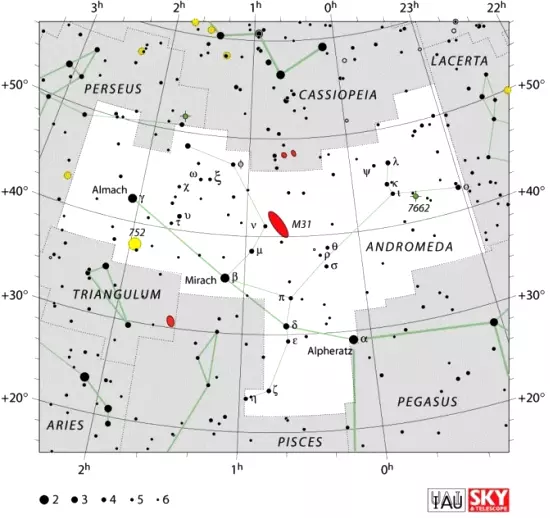
Andromeda constellation map, by IAU and Sky&Telescope magazine (Roger Sinnott & Rick Fienberg) (CC BY 3.0)
Andromeda myth
In Greek mythology, Andromeda was the daughter of King Cepheus of Ethiopia and Queen Cassiopeia, who offended the Nereids (sea nymphs) by claiming she was more beautiful than they were.
The nymphs complained to the sea god Poseidon and he sent a sea monster, Cetus, to flood and destroy Cepheus’ lands as punishment for his wife’s boastfulness. When the king sought advice from the Oracle of Ammon on how to prevent complete destruction of his lands, he was told that the only way to appease the gods and nymphs was to sacrifice his daughter to Cetus. Subsequently, Andromeda was chained to a rock and would have been left to the monster if the hero Perseus had not come along and saved her. The two were later married and had six children, including Gorgophonte, who fathered Tyndareus, the famous Spartan king, and Perses, who was an ancestor of the Persians.
In the story, it was the goddess Athena who commemorated the princess Andromeda by placing her image among the stars, next to the constellations representing her husband Perseus and mother Cassiopeia.
Major stars in Andromeda
Alpheratz – α Andromedae (Alpha Andromedae)
The brightest star in Andromeda is Alpheratz, Alpha Andromedae. It is sometimes also known as Sirrah. The star is located 97 light years from Earth.
Alpheratz is a binary star with an apparent magnitude of +2.06. It is a hot blue star classified as a B8 subgiant. The brighter of the two stars in the binary system has an unusual chemical composition, with unusually high levels of mercury, manganese, and other elements. Alpheratz is the brightest mercury-manganese star known, with a luminosity 200 times that of the Sun. Its mass is approximately 3.6 solar masses and its surface temperature is about 13,800 K.
The companion star is also more massive than the Sun and has a luminosity 10 times that of the Sun. The two stars orbit each other with a period of 96.7 days.
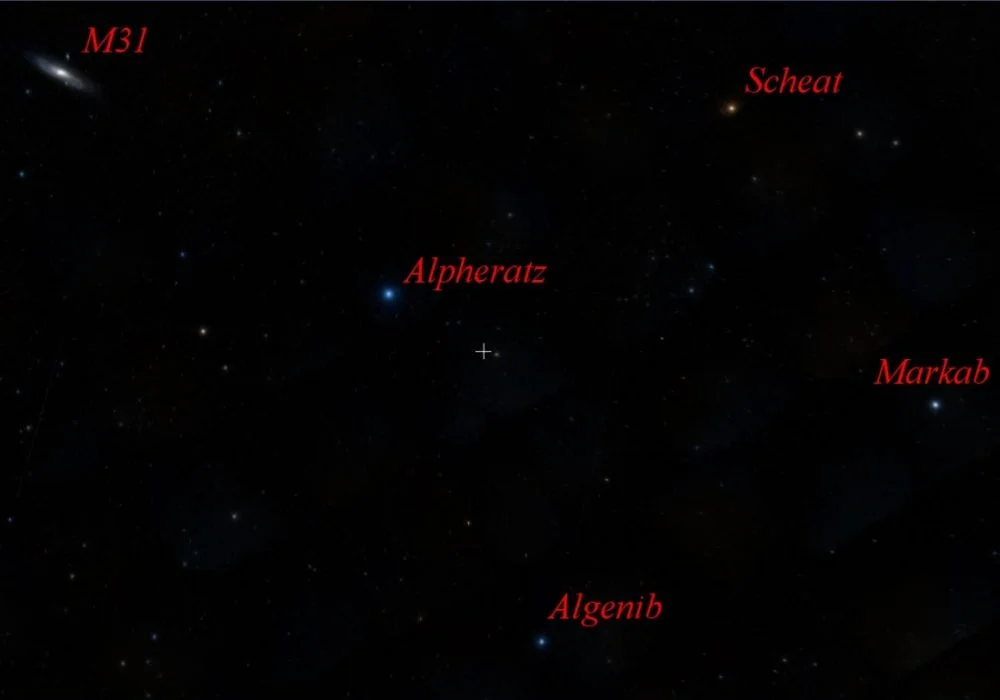
Andromeda Galaxy, Alpheratz and the Great Square of Pegasus, image: Wikimedia Commons/Betelguese
Alpheratz was once considered to be part of the Pegasus constellation. In addition to being designated Alpha Andromedae, it had the second designation, Delta Pegasi. Both of its traditional names, Alpheratz and Sirrah, are derived from the Arabic phrase al surrat al-faras, which means “the navel of the horse.” The horse refers to Pegasus.
Arabian astronomers also called the star al ras al mar’ah al musalsalah, which means “the head of the chained woman.”
Alpheratz is the northeastern star of the Great Square of Pegasus. The three other stars that form the square are Alpha, Beta and Gamma Pegasi (Markab, Scheat, and Algenib respectively). Alpheratz connects the Andromeda constellation with Pegasus, the horse Perseus rode to Andromeda’s rescue.
Mirach – β Andromedae (Beta Andromedae)
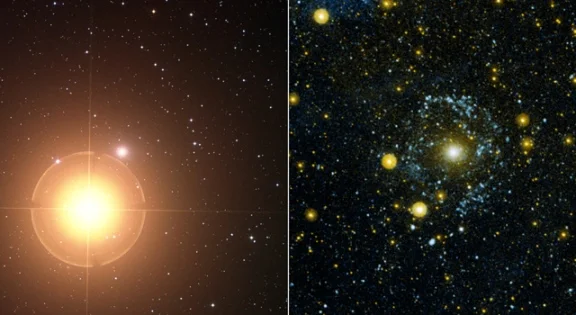
Mirach and NGC 404 (the Ghost of Mirach), image: NASA
Mirach, Beta Andromedae, has roughly same apparent magnitude as Alpheratz, as it varies from +2.01 to +2.10. It is classified as a suspected semi-regular variable.
Mirach is a cool, bright red class M giant approximately 200 light years distant. It is 1,900 times more luminous than the Sun and 3-4 times more massive. It has a magnitude 14 hydrogen-fusing companion.
Mirach is part of an asterism called the girdle. The name Mirach is a corrupted derivation from the Arabic word for “girdle,” mizar, referring to the star’s placement at Andromeda’s left hip.
Mirach is located only seven arcminutes from the galaxy NGC 404. Nicknamed the Ghost of Mirach, NGC 404 is a dwarf lenticular galaxy located about 10 million light years from Earth.
Almach – γ Andromedae (Gamma Andromedae)
Almach, Gamma Andromedae, is the third brightest star in the constellation. It is a multiple star system. Its name comes from the Arabic al-‘anaq al-‘ard, which means “caracal” or “the desert lynx.” Almach is approximately 350 light years distant.
The brighter component of the Almach system, Gamma1 Andromedae, is a golden yellow giant, while the companion is blue. The two stars are separated by about 10 arcseconds on the sky. The primary star is a class K bright giant. It has an apparent magnitude of 2.26 and is about 355 light years distant. It is 2,000 times more luminous than the Sun.
The fainter companion star, Gamma2 Andromedae, is itself a binary star, consisting of fifth and sixth magnitude white dwarf stars. The brighter component is also a double star.
δ Andromedae (Delta Andromedae)
Delta Andromedae is a double star with an apparent magnitude of 3.28, approximately 101 light years distant from the solar system. The brighter component is a K-type giant, while the dimmer companion is either a G-type main sequence star or a white dwarf.
ι Andromedae (Iota Andromedae)
Iota Andromedae is a B-type main sequence dwarf, bluish white in colour. It has a magnitude of +4.29 and is 503 light years distant.
υ Andromedae (Upsilon Andromedae)
Upsilon Andromedae is another binary star system in the Andromeda constellation, composed of a yellow-white dwarf and a fainter red dwarf. The primary star, Upsilon Andromedae A, has four planets in orbit, presumed to be Jovian planets (similar to Jupiter). With an age of 3.1 billion years, the star is younger than the Sun, as well as more massive and more luminous. Upsilon Andromedae B is a red dwarf located 750 AU from the primary star. It is both less massive and less luminous than the Sun.
Upsilon Andromedae is 44 light years distant. It is ranked 21st on the list of the top 100 target stars for the NASA Terrestrial Planet Finder mission.
Adhil – ξ Andromedae (Xi Andromedae)
Adhil, or Xi Andromedae, is also a double star. Its name derives from the Arabic word al-dhayl, which means “train” (or literally “tail”). Adhil is approximately 196 light years distant and has an apparent magnitude of +4.875. Its spectral class is G9.
Nembus – 51 Andromedae
With an apparent magnitude of 3.57, Nembus, or 51 Andromedae, is the fifth brightest star in the constellation. It is an orange K-type giant 177 light years distant. Even though Ptolemy originally included the star in the Andromeda constellation, Johann Bayer later moved it to Perseus as Upsilon Persei. English astronomer John Flamsteed later moved it back to Andromeda, where it has stayed to this day.
μ Andromedae (Mu Andromedae)
Mu Andromedae is a white A-type dwarf located approximately 136 light years from Earth. It has an apparent magnitude of +3.86.
Other notable stars:
Pi Andromedae is another binary star, approximately 660 light years distant. The primary component has an apparent magnitude of 4.3, while the fainter companion is a 9th magnitude star.
R Andromedae is a Mira-type variable star that appears about four degrees southwest of the Andromeda Galaxy. Its brightness varies between 5.8 and 14.9 over a period of 409 days.
RX Andromedae is a Z Camelopardalis-type variable star. Its brightness varies between magnitude 10.3 and 14 over a period of 14 days.
56 Andromedae is a binary star consisting of two magnitude six components.
Groombridge 34 is also a binary star, consisting of two red dwarfs. Only 11.7 light years distant, it is one of the closest double stars to the Sun. The two components are designated GX Andromedae (Groombridge 34 A) and GQ Andromedae (Groombridge 34 B).
Deep sky objects in Andromeda
Andromeda Galaxy (Messier 31, M31, NGC 224)
Messier 31 (NGC 224), better known as the Andromeda Galaxy, is a spiral galaxy approximately 2.5 million light years distant. In the past, before astronomers knew what it was, the galaxy was referred to as the Great Andromeda Nebula.
Andromeda Galaxy is the closest spiral galaxy to the Milky Way and the farthest object in the night sky visible to the unaided eye. It has an apparent magnitude of 3.4, which makes it one of the brightest Messier objects. The galaxy contains a trillion stars. This is significantly more than the Milky Way, which has approximately 200-400 billion stars.
Only the brightest central region of the Andromeda Galaxy is visible through a small telescope but, in a larger telescope, the Andromeda Galaxy is about six times as wide as the full Moon.
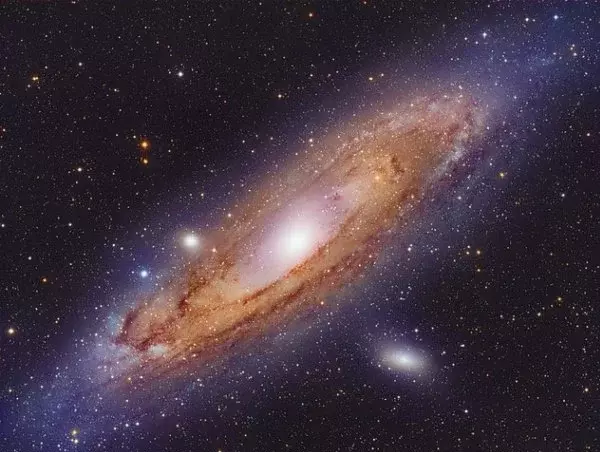
Andromeda Galaxy (Messier 31), image: Ivan Bok (CC BY 4.0)
Andromeda belongs to the Local Group of galaxies, along with the Milky Way, Triangulum Galaxy (Messier 33), and 30 or so smaller galaxies. Andromeda is the largest of the group. Its mass is estimated to be roughly equal to that of the Milky Way Galaxy, with which it is expected to collide in about 4.5 billion years.
Andromeda satellites
Andromeda has at least 14 dwarf galaxies orbiting it, including M32 and M110. Other satellite galaxies are considerably fainter and were not discovered until the 1970s. They include the dwarf spheroidal galaxies NGC 147, NGC 185 and the Cassiopeia Dwarf (Andromeda VII) in Cassiopeia constellation, Andromeda I, Andromeda II, Andromeda III, Andromeda V, Andromeda VIII, Andromeda IX and Andromeda X in Andromeda constellation, Andromeda VI, also known as the Pegasus Dwarf Spheroidal galaxy, in Pegasus constellation, and Andromeda XXII, also known as Pisces VI or Triangulum I, located in the constellation Pisces. The Triangulum Galaxy (M33), the famous spiral galaxy in the constellation Triangulum, is also believed to be a satellite of the Andromeda Galaxy.
NGC 206
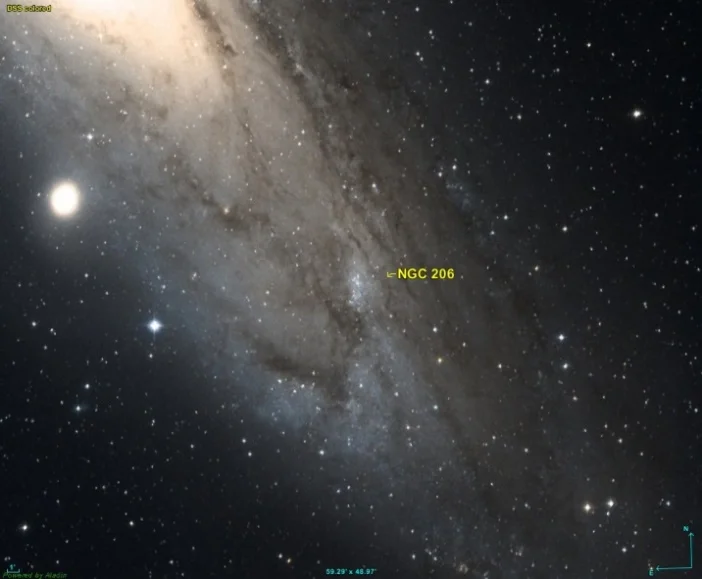
Star cloud NGC 206. Image: Donald Pelletier (CC BY-SA 4.0)
NGC 206 is a star cloud in the Andromeda Galaxy. It is the brightest star cloud in M31 seen from Earth and one of the largest star forming regions in the Local Group of galaxies.
The cloud contains a number of very bright stars and is located in a zone free of neutral hydrogen in one of Andromeda’s spiral arms. It spans about 400 light years and has an apparent size of 4.2’.
Andromeda’s Cluster – Mayall II
Mayall II (NGC 224-G1) is a globular cluster orbiting the Andromeda Galaxy. The cluster is located about 130,000 light years from M31’s core and is the brightest globular cluster in the Local Group of galaxies. It has an apparent magnitude of 13.7.
The cluster has twice the mass of Omega Centauri, the largest globular cluster in the Milky Way. It is believed to contain an intermediate-mass black hole in its centre. Some astronomers suspect that Mayall II is not a true globular cluster, but the remaining core of a dwarf galaxy that was consumed by the larger M31.
The cluster was named after the American astronomer Nicholas Mayall, who discovered it with O.J. Eggen in 1953.
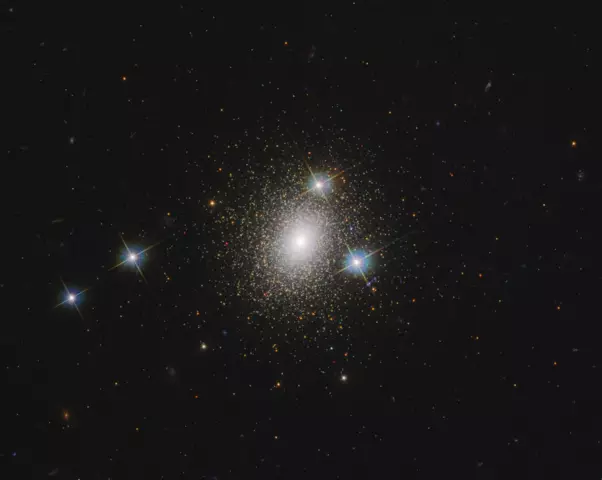
Mayall II (Andromeda’s Cluster), image: Judy Schmidt (CC BY 2.0)
Messier 32 (NGC 221)
Messier 32, a dwarf elliptical galaxy approximately 2.65 million light years distant, was originally discovered by the French astronomer Guillaume Le Gentil in 1749. The galaxy is still occasionally known by the astronomer’s last name, Le Gentil.
Messier 32 was the first elliptical galaxy ever discovered. It is a satellite of the Andromeda Galaxy. M32 is small, but quite bright, and can easily be seen in a small telescope.
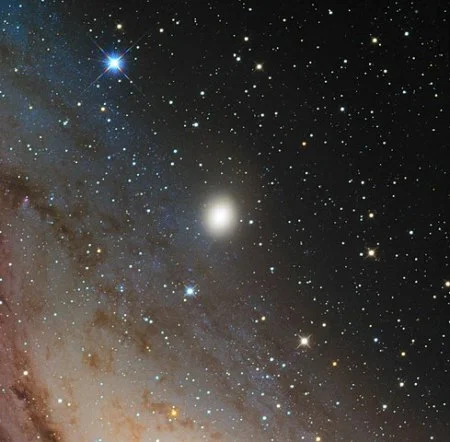
Dwarf galaxy Messier 32 in Andromeda, image: Fabrizio Francione (CC BY-SA 4.0)
It is located 22 arcminutes south of Andromeda’s central region. It appears spread over Andromeda’s spiral arms and is believed to be on the side that is closer to us. M32 does not contain any globular clusters. The galaxy is suspected to have been much larger at one point, but then lost its outer stars and globular clusters when it collided with the Andromeda Galaxy.
M32 is about 6,500 in diameter and mostly contains old stars, with no star formation going on inside the galaxy. It has a supermassive black hole in its centre. The mass of the black hole is estimated to be between 1.5 and 5 million solar masses.
Along with Messier 110, Messier 32 is the closest bright elliptical galaxy to our solar system.
Messier 110 (NGC 205)
Messier 110 is a dwarf elliptical galaxy. It is often classified as a dwarf spheroidal galaxy. It contains eight globular clusters in the halo that surrounds it.
Atypical for a dwarf elliptical galaxy, M110 is showing signs of recent star formation. It does not appear to have a supermassive black hole, or at least there is no evidence that one exists at the centre of the galaxy.
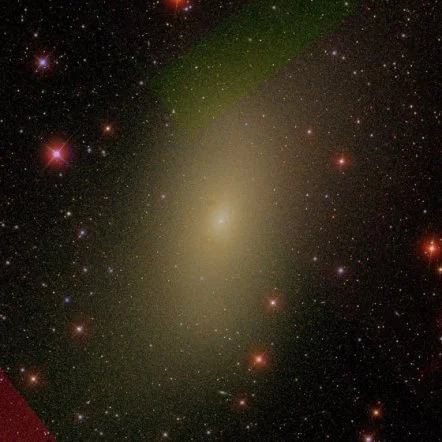
Messier 110, image: Sloan Digital Sky Survey
Messier 110 was observed and described by Charles Messier in 1773 together with the Andromeda Galaxy and other objects he discovered, but M110 was not included on his original list of objects.
The galaxy was independently discovered by Caroline Herschel a decade later. Her discovery was documented by her brother William Herschel in 1785, but it was not given a Messier catalogue number until 1967, when Kenneth Glyn Jones finally gave it one.
M110 is about 2.9 million light years distant.
NGC 752
NGC 752 (Caldwell 28) is an open cluster with an apparent magnitude of 5.7, located at a distance of 1,300 light years from Earth. The cluster was discovered by Caroline Herschel in 1783, but may have been observed by Giovanni Batista Hodierna before 1654. It was catalogued by Caroline Herschel’s brother William Herschel in 1786.
NGC 752 is bright, large, and easily seen through binoculars. In exceptionally good conditions, it is even visible to the unaided eye. None of the stars in the cluster are brighter than 9th magnitude.
NGC 891
NGC 891 is an edge-on spiral galaxy which can be seen four degrees east of Almach (Gamma Andromedae). It is visible in 4.5-inch telescopes. The galaxy has an apparent magnitude of 10.8 and is located at an approximate distance of 27.3 million light years from Earth. It occupies an area 13’.5 x 2’.5 in size. It appears as our own galaxy, the Milky Way, would appear seen edge-on.
NGC 891 was discovered by William Herschel on October 6, 1784. It belongs to the NGC 1023 Group. A supernova was observed in the galaxy on August 21, 1986. It was designated SN 1986J and peaked at magnitude 14.
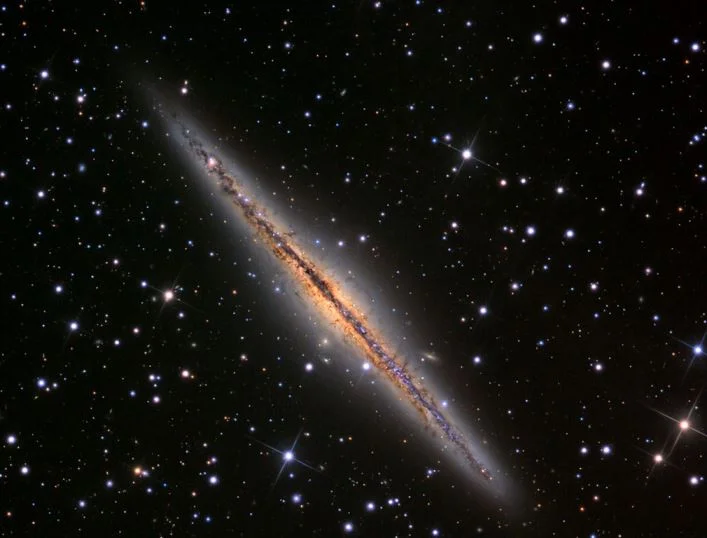
NGC 891, image: Adam Block/Mount Lemmon SkyCenter/University of Arizona (CC BY-SA 3.0 US)
NGC 7686
NGC 7686 is an open cluster with an apparent magnitude of 5.6. It is 900 light years distant. The cluster contains about 80 stars and is easily seen with binoculars and small telescopes.
Blue Snowball Nebula – NGC 7662
The Blue Snowball Nebula (or simply Snowball Nebula) is catalogued as NGC 7662 in the New General Catalogue. It is a planetary nebula with an apparent magnitude of 8.6, appearing a degree west of the magnitude 4 star Kappa Andromedae.
The nebula’s distance is uncertain and estimated to be between 2,000 and 6,000 light years. The central star is a bluish dwarf with an estimated temperature of 75,000 K. The nebula’s estimated radius is 0.8 light years.
The Blue Snowball Nebula can be seen in a small refractor telescope, but only appears as a star-like object with some nebulosity.
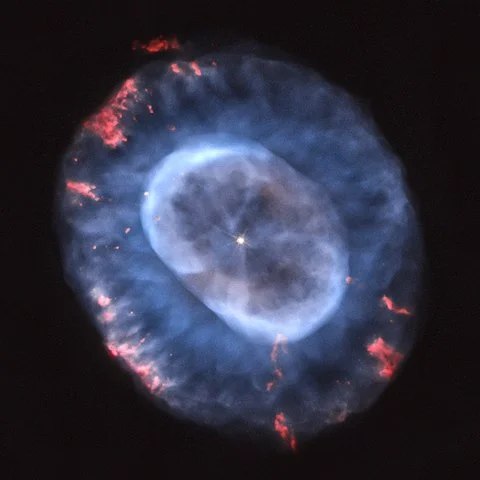
Caldwell 22, also cataloged as NGC 7662 and nicknamed the Snowball Nebula or Blue Snowball Nebula, is a planetary nebula located about 2,500 light-years from Earth. Nebulas like these represent a stage in evolution that stars like our Sun undergo when they run out of fuel. Stars are nuclear furnaces that spend most of their lives fusing hydrogen into helium. Massive stars have fiery fates, ending their lives as supernovae, but medium-mass stars like the Sun swell to become red giants as they exhaust their fuel. The process begins when, after billions of years of nuclear fusion, the star starts to shut down. Gravity (no longer balanced by the outward pressure created by nuclear fusion) compresses the stellar core. The star’s outer layers of gas puff away into space, creating a planetary nebula (so named because these objects often resemble planetary orbs when viewed through a small telescope). At the center lie the remains of the original star’s compressed core, a small white dwarf. One day the Sun will meet a similar fate, but it has enough fuel to last another 6 billion years or so. This image was taken using Hubble’s Wide Field and Planetary Camera 2 in 2000. Astronomers compared this image to earlier Hubble images of Caldwell 22 to study how the nebula expanded and changed. Credit: NASA, ESA and A. Hajian (University of Waterloo)
NGC 68 Group
The NGC 68 Group (Arp 113) is a cluster of more than 40 galaxies centered on the elliptical galaxy NGC 68. The group is located at an approximate distance of 300 million light years. It was discovered in 1784 by William Herschel, who catalogued the galaxies as a single object. The Danish-Irish astronomer John Louis Emil Dreyer was able to make out some of the individual members and catalogued them as NGC 68, NGC 70 and NGC 71 in the 1880s.
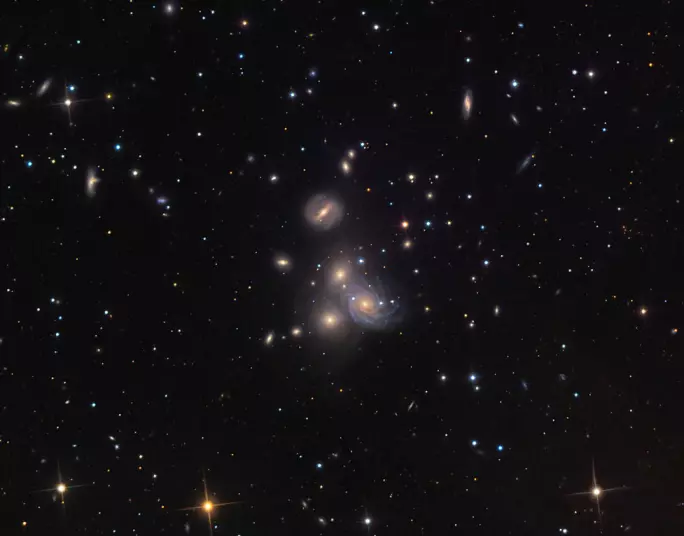
NGC 68 Group. Image: Adam Block/Mount Lemmon SkyCenter/University of Arizona (CC BY-SA 3.0 US)
The main members of the NGC 68 Group are the galaxies NGC 68, NGC 67, NGC 67a, NGC 69, NGC 70, NGC 71, NGC 72, NGC 72a, and NGC 74. A smaller cluster can be seen superimposed on the group that includes AGC 102760, UGC 152, and UGC 166.
NGC 68 is classified as an E1-type elliptical galaxy. It has a visual magnitude of 12.9 and is located at an approximate distance of 260 million light years from Earth. It spans 90,000 light years and has an apparent size of 1.288’ x 1.202’. The galaxy was discovered by William Herschel on September 11, 1784, along with NGC 70.
NGC 67 is an elliptical (E5) galaxy with an apparent magnitude of 14.2, located 275 million light years from Earth. It was discovered by R.J. Mitchell on October 7, 1855, along with NGC 69, NGC 70 and NGC 72. The galaxy is 40,000 light years across and has an apparent size of 24’’ x 12’’.
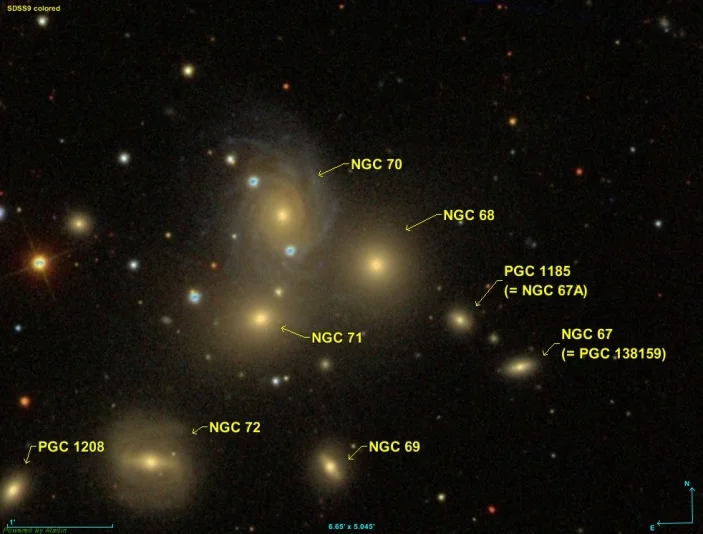
NGC 68 Group. Image: Donald Pelletier
NGC 67a is also an E5-type elliptical galaxy. It has a visual magnitude of 14.7 and is 287 million light years distant. It occupies an area 0.4’ by 0.2’ in size, which translates into a real size of 35,000 light years.
NGC 69 is a lenticular (S0) galaxy with an apparent magnitude of 14.7. It is 300 million light years distant and spans 80,000 light years, or 0.9’ x 0.8’ of the apparent sky.
NGC 70 is a spiral galaxy spanning 180,000 light years. It has a visual magnitude of 13.5 and is about 320 million light years distant. It occupies an area 1.7’ x 1.4’ in size.
NGC 71 is either an elliptical or lenticular galaxy (E5/S0) about 130,000 light years across, located about 310 million light years from the Sun. It is the second largest galaxy in the group, smaller only than NGC 70. The galaxy has an apparent magnitude of 13.2.
NGC 72 is a barred spiral galaxy with an apparent magnitude of 13.5, located approximately 320 million light years away. It spans about 120,000 light years, which translates to an apparent size of 1.3’ x 1.0’.
NGC 72a is another elliptical (E3) galaxy in the group. It is located at a distance of 308 light years and has a visual magnitude of 14.7. It has an apparent size of 0.3’ x 0.3’ and an actual size of 25,000 light years.
NGC 74 is a spiral galaxy that spans 65,000 light years. It is 315 million light years distant and has an apparent magnitude of 15.3. The galaxy was discovered by the Irish astronomer William Parsons on October 7, 1855.
Arp 65 – NGC 90 and NGC 93
NGC 90 and NGC 93 form a pair of interacting spiral galaxies in Andromeda. NGC 90 is located at a distance of 333.8 million light years and NGC 93 is 259.7 million light years away. The galaxies were discovered by R.J. Mitchell in 1854. NGC 90 has an apparent magnitude of 13.7 and an apparent size of 2.4’ x 0.91’. It has two distorted, elongated spiral arms that show evidence of starburst activity, likely caused by the interaction. NGC 93 has a visual magnitude of 14.34 and occupies an area 1.4’ x 0.7’ in size.
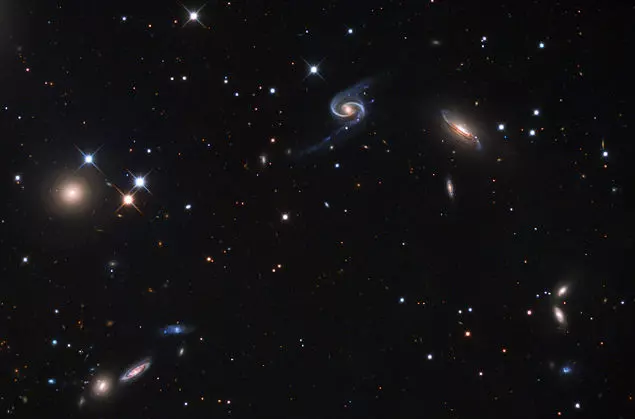
NGC 90 (centre) and NGC 93 (top right). Image: Adam Block/Mount Lemmon SkyCenter/University of Arizona
Ghost of Mirach – NGC 404
NGC 404 is an isolated dwarf lenticular galaxy located just beyond our Local Group. The galaxy has an apparent magnitude of 11.2 and is located at an approximate distance of 10 million light years. It can be seen in small telescopes. The galaxy was discovered by William Herschel in 1784.
NGC 404 has an apparent size of 3.5’ x 3.5’. It is located 7 arcminutes from Mirach and is sometimes called the Ghost of Mirach because its proximity to the star makes it difficult to observe and photograph.
Andromeda contains a number of other deep sky objects that were included in the New General Catalogue, including the open cluster NGC 272, the spiral galaxies NGC 11, NGC 13, NGC 21, NGC 228, NGC 48, NGC 214, NGC 218, NGC 226, NGC 260, NGC 280, NGC 39, NGC 27, NGC 19, NGC 169, NGC 184, NGC 140, NGC 109, NGC 160, and NGC 112, lenticular galaxies NGC 81, NGC 149, NGC 20, NGC 76, NGC 69, NGC 229, NGC 243, NGC 304, NGC 43, NGC 80, NGC 393, NGC 389, NGC 94, NGC 258, NGC 96, NGC 108, NGC 86, and NGC 252, and elliptical galaxies NGC 5, NGC 49, NGC 233, NGC 1000, NGC 79, NGC 97, NGC 83, and NGC 183.